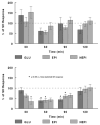Acute THPVP inactivation decreases the glucagon and sympathoadrenal responses to recurrent hypoglycemia
- PMID: 18191818
- PMCID: PMC2613786
- DOI: 10.1016/j.brainres.2007.11.040
Acute THPVP inactivation decreases the glucagon and sympathoadrenal responses to recurrent hypoglycemia
Erratum in
- Brain Res. 2008 Dec 3;1243:175
Abstract
The posterior paraventricular nucleus of the thalamus (THPVP) has been identified as a forebrain region that modulates the central nervous system (CNS) response to recurrent experiences of stressors. The THPVP is activated in response to a single (SH) or recurrent (RH) experience of the metabolic stress of hypoglycemia. In this study, we evaluated whether temporary experimental inactivation of the THPVP would modify the neuroendocrine response to SH or RH. Infusion of lidocaine (LIDO) or vehicle had no effect on the neuroendocrine response to SH, comparable to findings with other stressors. THPVP vehicle infusion concomitant with RH resulted in a prevention of the expected impairment of neuroendocrine responses, relative to SH. LIDO infusion with RH resulted in significantly decreased glucagon and sympathoadrenal responses, relative to SH. These results suggest that the THPVP may contribute to the sympathoadrenal stimulation induced by hypoglycemia; and emphasizes that the THPVP is a forebrain region that may contribute to the coordinated CNS response to metabolic stressors.
Figures



Similar articles
-
Inactivation of the PVN during hypoglycemia partially simulates hypoglycemia-associated autonomic failure.Am J Physiol Regul Integr Comp Physiol. 2003 Jan;284(1):R57-65. doi: 10.1152/ajpregu.00439.2002. Epub 2002 Oct 10. Am J Physiol Regul Integr Comp Physiol. 2003. PMID: 12388440
-
Inactivation of the DMH selectively inhibits the ACTH and corticosterone responses to hypoglycemia.Am J Physiol Regul Integr Comp Physiol. 2004 Jan;286(1):R123-8. doi: 10.1152/ajpregu.00328.2003. Am J Physiol Regul Integr Comp Physiol. 2004. PMID: 14660476
-
I.c.v. administration of the nonsteroidal glucocorticoid receptor antagonist, CP-472555, prevents exacerbated hypoglycemia during repeated insulin administration.Neuroscience. 2006 Jun 30;140(2):555-65. doi: 10.1016/j.neuroscience.2006.02.041. Epub 2006 Apr 19. Neuroscience. 2006. PMID: 16626867
-
Coordinated responses of glucogenic hormones to central glucopenia: the role of the sympathoadrenal system.Adv Metab Disord. 1983;10:469-83. doi: 10.1016/b978-0-12-027310-2.50025-6. Adv Metab Disord. 1983. PMID: 6364722 Review.
-
Sympathoadrenal system in neuroendocrine control of glucose: mechanisms involved in the liver, pancreas, and adrenal gland under hemorrhagic and hypoglycemic stress.Can J Physiol Pharmacol. 1992 Feb;70(2):167-206. doi: 10.1139/y92-024. Can J Physiol Pharmacol. 1992. PMID: 1521177 Review.
Cited by
-
Expression of the diabetes-associated gene TCF7L2 in adult mouse brain.J Comp Neurol. 2009 Dec 20;517(6):925-39. doi: 10.1002/cne.22199. J Comp Neurol. 2009. PMID: 19845015 Free PMC article.
-
Moderate recurrent hypoglycemia during early development leads to persistent changes in affective behavior in the rat.Brain Behav Immun. 2010 Jul;24(5):839-49. doi: 10.1016/j.bbi.2009.11.013. Epub 2009 Nov 26. Brain Behav Immun. 2010. PMID: 19944751 Free PMC article.
-
Review of the neuroanatomic landscape implicated in glucose sensing and regulation of nutrient signaling: immunophenotypic localization of diabetes gene Tcf7l2 in the developing murine brain.J Chem Neuroanat. 2012 Oct;45(1-2):1-17. doi: 10.1016/j.jchemneu.2012.06.002. Epub 2012 Jul 13. J Chem Neuroanat. 2012. PMID: 22796301 Free PMC article. Review.
-
Recurrent hypoglycemia alters hypothalamic expression of the regulatory proteins FosB and synaptophysin.Am J Physiol Regul Integr Comp Physiol. 2008 Nov;295(5):R1446-54. doi: 10.1152/ajpregu.90511.2008. Epub 2008 Aug 27. Am J Physiol Regul Integr Comp Physiol. 2008. PMID: 18753263 Free PMC article.
References
-
- Albert DJ, Madryga FJ. An examination of the functionally effective spread of 4 microliters of slowly infused lidocaine. Behav Neural Biol. 1980;29:378–384. - PubMed
-
- American Physiological Society. Guiding principles for research involving animals and human beings. Am J Physiol, Regul Integr Comp Physiol. 2002;283:R281–R283. - PubMed
-
- Bhatnagar S, Huber R, Nowak N, Trotter P. Lesions of the posterior paraventricular thalamus block habituation of hypothalamic–pituitary–adrenal responses to repeated restraint. J Neuroendocrinol. 2002;14:403–410. - PubMed
-
- Cryer PE. Hypoglycemia unawareness in IDDM. Diabetes Care. 1993;16:40–47. - PubMed
Publication types
MeSH terms
Substances
Grants and funding
LinkOut - more resources
Full Text Sources
Medical

